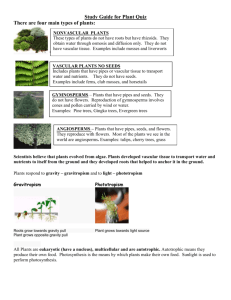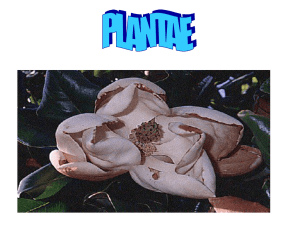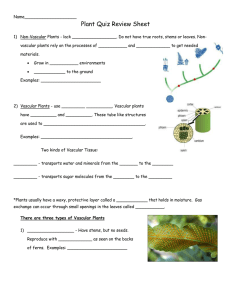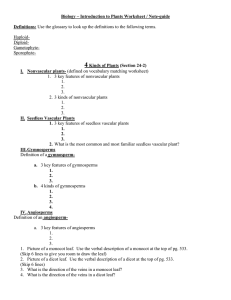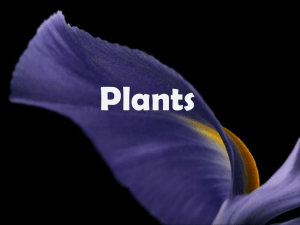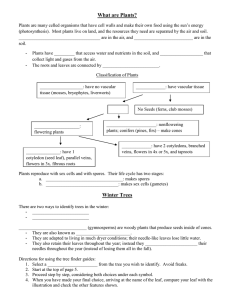Study Guide for Plant Quiz
advertisement
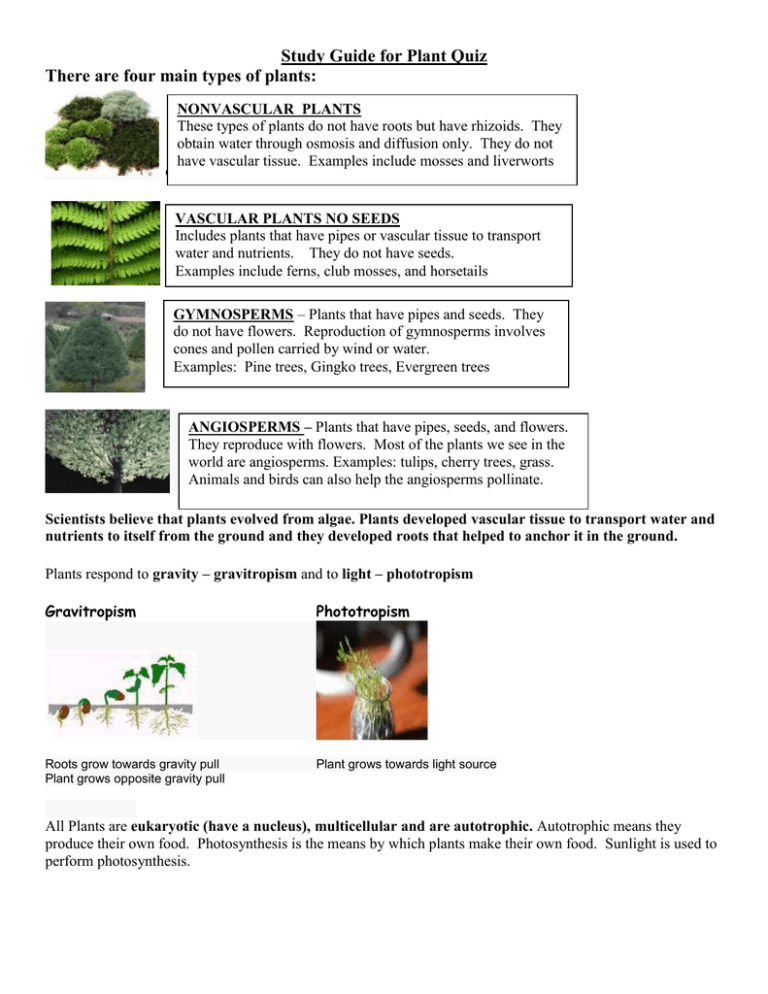
Study Guide for Plant Quiz There are four main types of plants: NONVASCULAR PLANTS These types of plants do not have roots but have rhizoids. They obtain water through osmosis and diffusion only. They do not have vascular tissue. Examples include mosses and liverworts onvascular plants VASCULAR PLANTS NO SEEDS Includes plants that have pipes or vascular tissue to transport water and nutrients. They do not have seeds. Examples include ferns, club mosses, and horsetails GYMNOSPERMS – Plants that have pipes and seeds. They do not have flowers. Reproduction of gymnosperms involves cones and pollen carried by wind or water. Examples: Pine trees, Gingko trees, Evergreen trees ANGIOSPERMS – Plants that have pipes, seeds, and flowers. They reproduce with flowers. Most of the plants we see in the world are angiosperms. Examples: tulips, cherry trees, grass. Animals and birds can also help the angiosperms pollinate. Scientists believe that plants evolved from algae. Plants developed vascular tissue to transport water and nutrients to itself from the ground and they developed roots that helped to anchor it in the ground. Plants respond to gravity – gravitropism and to light – phototropism Gravitropism Phototropism Roots grow towards gravity pull Plant grows opposite gravity pull Plant grows towards light source All Plants are eukaryotic (have a nucleus), multicellular and are autotrophic. Autotrophic means they produce their own food. Photosynthesis is the means by which plants make their own food. Sunlight is used to perform photosynthesis. Parts and functions of plant parts: Stems – support the plant and transport nutrients and water to plant. Leaves – protect the plant from losing or gaining too much water, and it is where the plant photosynthesizes. Most plant leaves are green because they have chloroplasts in their cells. Roots – anchor the plant in the ground, absorb water and nutrients, and store extra food. Most plants stay upright because they have vascular tissue that carry the water throughout the plant and keep it rigid. Xylem carries water and Pholem carries sugar. Top side of the leaf – is darker and there is a waxy coating on the top part of the leaf which helps hold water in and also keeps the leaf from getting too much water. It is where photosynthesis occurs in the cells of the leaf where the chloroplast are located. Bottom of leaf – lighter in color and not as exposed to the sun. Location where the gases exchange with the environment. Carbon dioxide is taken in and oxygen is given off. Pollination: The male part of the flower; the stamen produces the pollen which must be carried by bees or wind to the female part of the flower called the pistil. The bottom side of the leaf – is lighter and s Thehas pollen then fertilizes the ovule where a seed is produced; the new seed can grow or produce another plant. After the seed is fertilized, the ovary turns into a fruit. This cladogram shows the evolutionary relationships between PLANT TYPES. Nonvascular Vascular, seedless Gymnosperms Angiosperms flowers seeds vascular tissue cuticles, cell walls, multicellular, eukaryotic, autotrophic, do not move, asexual and sexual reproduction
